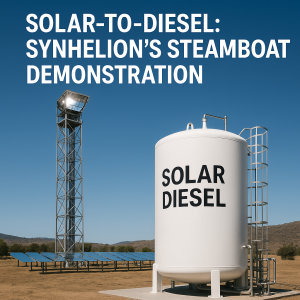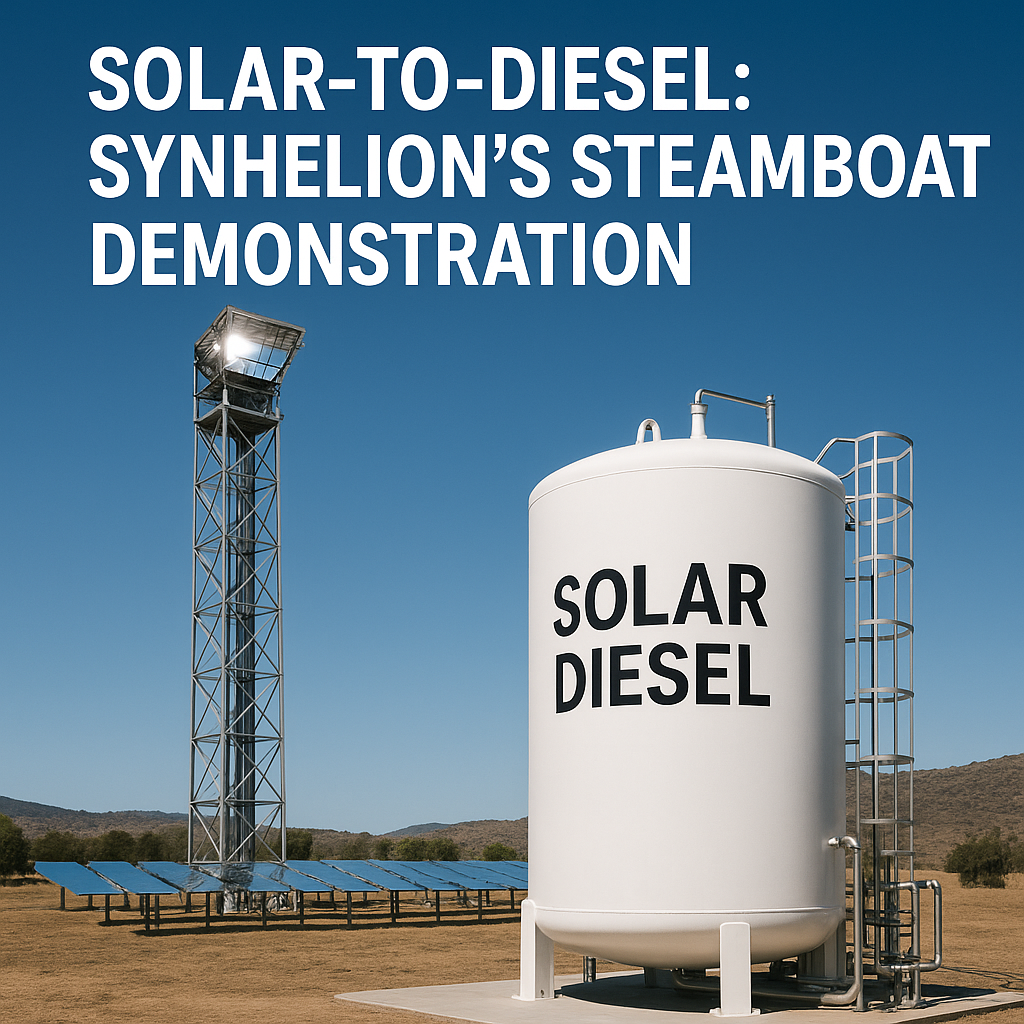Discover Synhelion’s solar-to-diesel breakthrough with a steamboat on Lake Lucerne. Explore how synthetic fuels could reshape maritime decarbonization.
 On a clear summer morning in 2023, the placid waters of Lake Lucerne in Switzerland reflected more than just alpine beauty. They mirrored a glimpse into the future of maritime energy. A steamboat, fueled not by traditional diesel, but by synthetic solar fuel, carried passengers in what became a world-first: a demonstration of solar-to-diesel technology applied to inland shipping.
On a clear summer morning in 2023, the placid waters of Lake Lucerne in Switzerland reflected more than just alpine beauty. They mirrored a glimpse into the future of maritime energy. A steamboat, fueled not by traditional diesel, but by synthetic solar fuel, carried passengers in what became a world-first: a demonstration of solar-to-diesel technology applied to inland shipping.
This project, spearheaded by Synhelion, a Swiss solar fuels company, was more than an experiment in clean energy. It was a symbol of possibility — showing that maritime decarbonization could be accelerated not only by electrification or hydrogen, but also by liquid synthetic fuels made directly from sunlight, CO₂, and water.
The event attracted attention far beyond Switzerland. For the shipping world, it was a proof-of-concept that could help bridge the gap between today’s carbon-heavy fuels and tomorrow’s net-zero alternatives.
Why This Topic Matters in Maritime Operations
Shipping is the backbone of global trade, carrying about 80–90% of world commerce by volume. Yet it is also one of the hardest-to-decarbonize sectors, currently responsible for nearly 3% of annual global CO₂ emissions. Unlike land transport, where electrification is advancing quickly, deep-sea and inland vessels demand high-density energy sources that can withstand long voyages and harsh conditions.
The International Maritime Organization (IMO) has set ambitious targets:
-
40% reduction in carbon intensity by 2030 compared to 2008 levels.
-
Net-zero GHG emissions “by or around 2050.”
To achieve these milestones, the maritime industry is exploring a portfolio of alternative fuels: green ammonia, hydrogen, methanol, biofuels — and now, solar-to-diesel synthetic fuels.
Synhelion’s demonstration matters because it offers a drop-in solution. Unlike ammonia or hydrogen, which require new engines and infrastructure, solar diesel can be used in existing marine engines with minimal modification. This makes it one of the most practical near-term pathways for fleet decarbonization without massive retrofits.
Key Developments, Innovations, or Technologies
Synhelion’s Solar-to-Fuel Technology
Synhelion, a spin-off from ETH Zurich, developed a process that uses concentrated solar power (CSP) to achieve temperatures exceeding 1,500°C — hot enough to drive chemical reactions that convert CO₂ and water into synthesis gas (syngas).
The process unfolds in stages:
-
CO₂ and H₂O Capture: Collected from air or industrial sources.
-
Solar Reactor: Mirrors concentrate sunlight to generate extreme heat, powering a thermochemical redox cycle.
-
Syngas Formation: The reactor produces a mixture of hydrogen (H₂) and carbon monoxide (CO).
-
Fuel Synthesis: Using Fischer-Tropsch processes, syngas is refined into solar kerosene, solar gasoline, or solar diesel.
The result is a carbon-neutral liquid fuel. When burned, it releases CO₂ — but only as much as was captured during production, closing the carbon loop.
The Lake Lucerne Steamboat Demonstration
In June 2023, a historic Swiss steamboat on Lake Lucerne became the stage for this breakthrough. Instead of conventional diesel, the ship’s auxiliary systems and engines were powered with solar diesel produced by Synhelion.
This event served three purposes:
-
Technical Proof: Showcasing compatibility of solar diesel with marine engines.
-
Public Engagement: Raising awareness about synthetic fuels among policymakers, industry leaders, and citizens.
-
Symbolic Value: Demonstrating that innovation can be tested not only in labs but also in cultural icons like Lake Lucerne’s steamships.
Advantages Over Other Fuels
-
Drop-in Capability: Works with current engines and bunkering infrastructure.
-
Energy Density: Similar to fossil diesel, superior to hydrogen or batteries in long-range maritime applications.
-
Carbon Neutrality: Creates a closed CO₂ cycle when produced with direct air capture.
-
Versatility: Can be blended with fossil fuels during the transition period.
In short, solar diesel combines the practicality of today’s fuels with the sustainability of tomorrow’s energy.
Challenges and Practical Solutions
While Synhelion’s technology holds promise, several challenges remain before solar diesel can fuel large fleets.
Production Scale and Cost
-
Challenge: Current production volumes are measured in liters, not tons. Costs are significantly higher than fossil diesel.
-
Solution: Scaling solar fuel plants. Synhelion is already building its first industrial-scale facility in Spain, expected to produce thousands of liters annually, with projections for exponential growth by 2030.
Infrastructure and Supply Chains
-
Challenge: Even if solar diesel is produced, global distribution networks for synthetic fuels are underdeveloped.
-
Solution: Leveraging existing diesel supply chains. Unlike hydrogen or ammonia, solar diesel doesn’t require entirely new bunkering infrastructure, lowering adoption barriers.
Policy and Regulatory Frameworks
-
Challenge: Without carbon pricing or subsidies, synthetic fuels remain economically uncompetitive.
-
Solution: Stronger regulatory push. The European Union’s FuelEU Maritime regulation and IMO carbon intensity measures could create market incentives for early adopters.
Environmental Trade-offs
-
Challenge: Solar fuel plants require large land areas for mirrors, often in sunny, arid regions. Concerns about land use and material needs persist.
-
Solution: Careful site selection in deserts and integration with industrial CO₂ emitters can reduce impacts while maximizing efficiency.
Case Studies / Real-World Applications
Synhelion’s Global Expansion
After Lake Lucerne, Synhelion is scaling its model internationally:
-
Spain Industrial Plant (2025): First large-scale production site.
-
Partnerships with Airlines: Lufthansa and SWISS have committed to testing solar kerosene for aviation.
-
Potential for Maritime Supply: Collaborations are expected with European inland shipping companies for pilot projects.
Comparative Maritime Examples
-
Biofuels in Europe: Ferries in the Netherlands have trialed waste-based biodiesel blends.
-
Methanol-Powered Ships: Maersk launched the world’s first large methanol-fueled container ship in 2023.
-
Hydrogen Ferries in Norway: MF Hydra demonstrates hydrogen viability on short-sea routes.
In this context, Synhelion’s solar-to-diesel stands out because it fits within existing engine frameworks, offering a smoother adoption curve.
Future Outlook & Trends
The path forward for solar diesel is intertwined with global energy transitions.
-
Short Term (2023–2027): Pilot demonstrations in inland waterways and aviation. Costs remain high, but awareness grows.
-
Medium Term (2027–2035): Industrial-scale plants bring down prices; maritime operators begin blending solar diesel with fossil fuels.
-
Long Term (2035–2050): Solar fuels potentially provide a significant share of deep-sea shipping energy demand, supporting IMO net-zero ambitions.
The technology is unlikely to dominate alone but will coexist with other solutions — methanol, ammonia, hydrogen, and batteries — depending on vessel type and operational profile.
Frequently Asked Questions (FAQ)
1. What is solar diesel?
Solar diesel is a synthetic, carbon-neutral fuel made from sunlight, CO₂, and water using thermochemical processes.
2. Why test it on a steamboat in Lake Lucerne?
The iconic Swiss steamboat provided a symbolic yet practical platform to showcase compatibility with marine engines and engage the public.
3. How is solar diesel different from biofuels?
Unlike biofuels, solar diesel doesn’t rely on agricultural land or biomass. It is produced entirely from sunlight and captured CO₂.
4. Can solar diesel be used in existing ships?
Yes. It is a drop-in fuel that works in current diesel engines with little or no modification.
5. Is solar diesel available commercially today?
Not yet at scale. Pilot plants exist, and industrial production is expected by the mid-2020s.
6. How expensive is solar diesel compared to marine diesel?
Currently several times more expensive, but costs are projected to decline significantly with scaling and carbon pricing policies.
7. Will solar fuels alone decarbonize shipping?
No single solution will dominate. Solar fuels will be part of a diverse portfolio of decarbonization strategies.
Conclusion
Synhelion’s solar-to-diesel steamboat demonstration on Lake Lucerne was not just a scientific showcase but a narrative of transition. It bridged Switzerland’s cultural heritage in steam navigation with the maritime industry’s urgent push toward decarbonization.
While the road ahead involves scaling, regulation, and economics, the message is clear: synthetic solar fuels can power ships today without waiting for entirely new technologies.
In the decades leading to 2050, as the maritime industry balances ambition with practicality, Synhelion’s breakthrough stands as a beacon of innovation, suggesting that sunlight itself can drive the future of shipping.
References
-
International Maritime Organization (IMO). (2023). IMO Strategy on Reduction of GHG Emissions from Ships.
-
Synhelion AG. (2023). Solar Fuels: Technology Overview.
-
European Commission (DG MOVE). (2023). FuelEU Maritime Regulation.
-
Wärtsilä. (2022). Future Fuels in Shipping: Pathways and Readiness.
-
MAN Energy Solutions. (2023). Synthetic Fuels and Marine Engines.
-
Lloyd’s Register. (2023). Alternative Fuels for Decarbonization.
-
UNCTAD. (2022). Review of Maritime Transport.
-
Marine Pollution Bulletin. (2022). Emerging Synthetic Fuel Pathways.
-
The Maritime Executive. (2023). “Synhelion Demonstrates Solar Fuel on Swiss Steamboat.”
-
S&P Global Commodity Insights. (2023). Synthetic Fuel Cost Outlook.
-
Britannica. (2023). Lake Lucerne Shipping History.

